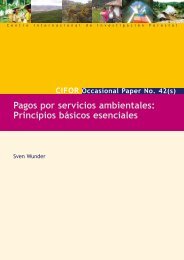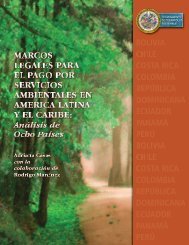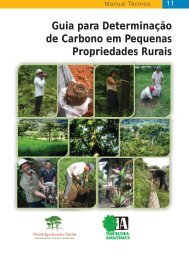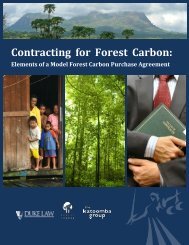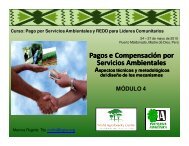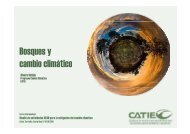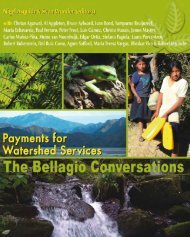Guide on Climate Change and Indigenous Peoples
Guide on Climate Change and Indigenous Peoples
Guide on Climate Change and Indigenous Peoples
- No tags were found...
You also want an ePaper? Increase the reach of your titles
YUMPU automatically turns print PDFs into web optimized ePapers that Google loves.
fish species, <strong>and</strong> rising sea levels withmore extreme tidal fluctuati<strong>on</strong>s.• Species that they rely <strong>on</strong> aredisappearing <strong>and</strong> that hunting routesnear shorelines have disappeared dueto erosi<strong>on</strong> brought <strong>on</strong> by the thawing ofpermafrost.• Villages have experienced increasedflooding in winter due to lessened ordisappearing pack ice that normally protects shorelines from surgingwater. Together with str<strong>on</strong>g winds, these cause damages to villages <strong>and</strong>destructi<strong>on</strong> of infrastructure found al<strong>on</strong>g coastlines <strong>and</strong> riverbanks.• Coastal <strong>and</strong> riverbank erosi<strong>on</strong> <strong>and</strong> rising of rivers have occurred dueto higher temperatures, thawing of permafrost, <strong>and</strong> melting mountainsnow, glaciers <strong>and</strong> sea ice. Erosi<strong>on</strong> of riverbanks cause riverbeds to risethereby creating shallow waters which threaten fish populati<strong>on</strong>s. Thisadversely impacts <strong>on</strong> subsistence fishing, another pillar of the traditi<strong>on</strong>alec<strong>on</strong>omy.• There are now reduced populati<strong>on</strong>s of animal species due to warmertemperatures <strong>and</strong> increase of new marine species entering the Arcticbecause of warmer sea water. Major changes in animal travel <strong>and</strong>migrati<strong>on</strong> routes have occurred.• Melting of sea ice will drastically shrink marine habitat for polar bears,ice-inhabiting seals <strong>and</strong> some seabirds. Plant, animal, fish, bird <strong>and</strong>insect species previously foreign to the Arctic are moving further northcausing the introducti<strong>on</strong> of new diseases.• The late freeze-up due to warmer temperatures has also led to somepositive impacts such as better whitefish harvests, clamming, spottedseal hunting, access to caribou, Arctic fox harvests <strong>and</strong> access todriftwood.• Unpredictable weather <strong>and</strong> entry of new species of plants, insects <strong>and</strong>animals challenge the traditi<strong>on</strong>al knowledge of indigenous peoples tocope with these developments.• Unusual rains during winter seas<strong>on</strong> cause ice formati<strong>on</strong>s which makesit harder for animals such as reindeer <strong>and</strong> caribou to access food whichhas serious impacts <strong>on</strong> the subsistence <strong>and</strong> ec<strong>on</strong>omies of indigenouspeoples.• The sovereignty of indigenous peoples in the Arctic <strong>and</strong> the States isunder threat due to the opening of the Northwest Passage, allowingfor easy entry of foreign hunters, traders <strong>and</strong> corporati<strong>on</strong>s which arec<strong>on</strong>stantly seeking for l<strong>and</strong>s <strong>and</strong> waters to extract resources from.• Increased sea traffic through the Canadian Arctic will make the westcoast of Greenl<strong>and</strong>, the north slope of Alaska <strong>and</strong> northern Russia morePART II: Impacts of <strong>Climate</strong> <strong>Change</strong> <strong>on</strong> <strong>Indigenous</strong> <strong>Peoples</strong> 21



